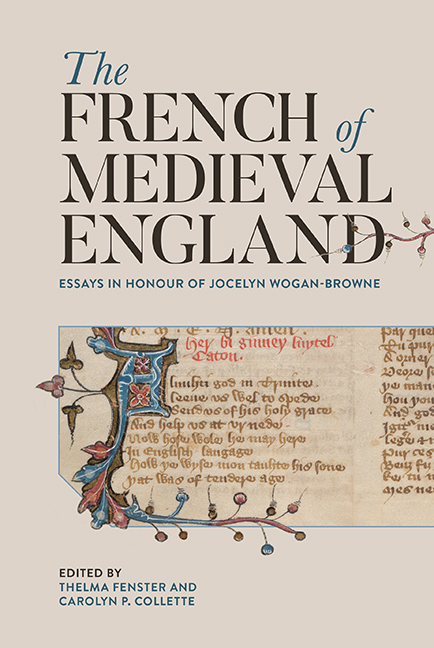Book contents
- Frontmatter
- Contents
- List of Illustrations
- List of Contributors
- List of Abbreviations
- Foreword: ‘The Light I Never Left Behind’: Jocelyn Wogan-Browne
- Introduction: Recognizing the French of Medieval England
- 1 The Gloss to Philippe de Thaon's Comput and the French of England's Beginnings
- 2 The Scandals of Medieval Translation: Thinking Difference in Francophone Texts and Manuscripts
- 3 Contrafacture and Translation: The Prisoner's Lament
- 4 Complaining about the King in French in Thomas Wright's Political Songs of England
- 5 The Chanson d’Aspremont in Bodmer 11 and Plantagenet Propaganda
- 6 The Use of Anglo-Norman in Day-to-Day Communication during the Anglo-Scottish Wars (1295–1314)
- 7 Middle English Borrowing from French: Nouns and Verbs of Interpersonal Cognition in the Early South English Legendary
- 8 William Langland Reads Robert Grosseteste
- 9 Disability Networks in the Campsey Manuscript
- 10 English Women and Their French Books: Teaching about the Jews in Medieval England
- 11 French Residents in England at the Start of the Hundred Years War: Learning English, Speaking English and Becoming English in 1346
- 12 French Immigrants and the French Language in Late-Medieval England
- 13 Fashioning a Useable Linguistic Past: The French of Medieval England and the Invention of a National Vernacular in Early Modern France
- 14 Admiring Ambivalence: on Paul Meyer's Anglo-Norman Scholarship
- 15 Twenty-First Century Gower: The Theology of Marriage in John Gower's Traitié and the Turn toward French
- 16 Royaumes sans frontières: The Place of England in the Long Twelfth Century
- Afterword
- Bibliography
- Index
- Publications of Jocelyn Wogan-Browne
- Tabula Gratulatoria
7 - Middle English Borrowing from French: Nouns and Verbs of Interpersonal Cognition in the Early South English Legendary
Published online by Cambridge University Press: 12 August 2020
- Frontmatter
- Contents
- List of Illustrations
- List of Contributors
- List of Abbreviations
- Foreword: ‘The Light I Never Left Behind’: Jocelyn Wogan-Browne
- Introduction: Recognizing the French of Medieval England
- 1 The Gloss to Philippe de Thaon's Comput and the French of England's Beginnings
- 2 The Scandals of Medieval Translation: Thinking Difference in Francophone Texts and Manuscripts
- 3 Contrafacture and Translation: The Prisoner's Lament
- 4 Complaining about the King in French in Thomas Wright's Political Songs of England
- 5 The Chanson d’Aspremont in Bodmer 11 and Plantagenet Propaganda
- 6 The Use of Anglo-Norman in Day-to-Day Communication during the Anglo-Scottish Wars (1295–1314)
- 7 Middle English Borrowing from French: Nouns and Verbs of Interpersonal Cognition in the Early South English Legendary
- 8 William Langland Reads Robert Grosseteste
- 9 Disability Networks in the Campsey Manuscript
- 10 English Women and Their French Books: Teaching about the Jews in Medieval England
- 11 French Residents in England at the Start of the Hundred Years War: Learning English, Speaking English and Becoming English in 1346
- 12 French Immigrants and the French Language in Late-Medieval England
- 13 Fashioning a Useable Linguistic Past: The French of Medieval England and the Invention of a National Vernacular in Early Modern France
- 14 Admiring Ambivalence: on Paul Meyer's Anglo-Norman Scholarship
- 15 Twenty-First Century Gower: The Theology of Marriage in John Gower's Traitié and the Turn toward French
- 16 Royaumes sans frontières: The Place of England in the Long Twelfth Century
- Afterword
- Bibliography
- Index
- Publications of Jocelyn Wogan-Browne
- Tabula Gratulatoria
Summary
The nature and scope of language use in mediaeval England were for a long time framed by the ‘bounded perceptions’ that arise when compartmentalised academic disciplines shape complex realities into pedagogically manageable narratives. Framed through the disciplinary lens of English, the French of medieval England tends to be cast in the role of the protagonist to be ousted from the field, after having passed on some language traits to Middle English, the victor in the supposed linguistic contest. Seen in a French disciplinary frame, the French of England is no more than an eccentric offshoot which withered and died after a short-lived period of moderate literary interest that contributed to the francophone authorial canon only the reassuringly surnamed Marie ‘de France’.
In recent decades a number of researchers in the UK and elsewhere have established a research agenda that allows new perspectives to be taken. It has become possible to envisage the linguistic landscape of medieval England as one in which languages, and the literary production in them, co-existed and interacted so closely that to carve out boundaries around them now seems not just artificial but actually damaging to the character of the objects of study. Jocelyn Wogan-Browne's work stands out for encouraging the use of French as a medium for writing in England to be seen as an integral part of the literary and spiritual context of the time, and the present article pursues one such aspect of the converging perspectives that her research and that of others has made possible: the integration of French lexis with English in the context of religious writing. In particular, we explore what the language of religious writing for a popular audience can reveal about the diffusion of French vocabulary in English, at a point well before the so-called ‘Frenchified’ vocabulary of Gower and Chaucer makes itself felt at the end of the fourteenth century.
The status of French in medieval England has undergone substantial reassessment in this century. It has been shown by several authors that insular French survived as a viable multi-genre communicative medium well into the fourteenth century.
- Type
- Chapter
- Information
- The French of Medieval EnglandEssays in Honour of Jocelyn Wogan-Browne, pp. 128 - 139Publisher: Boydell & BrewerPrint publication year: 2017
- 4
- Cited by

